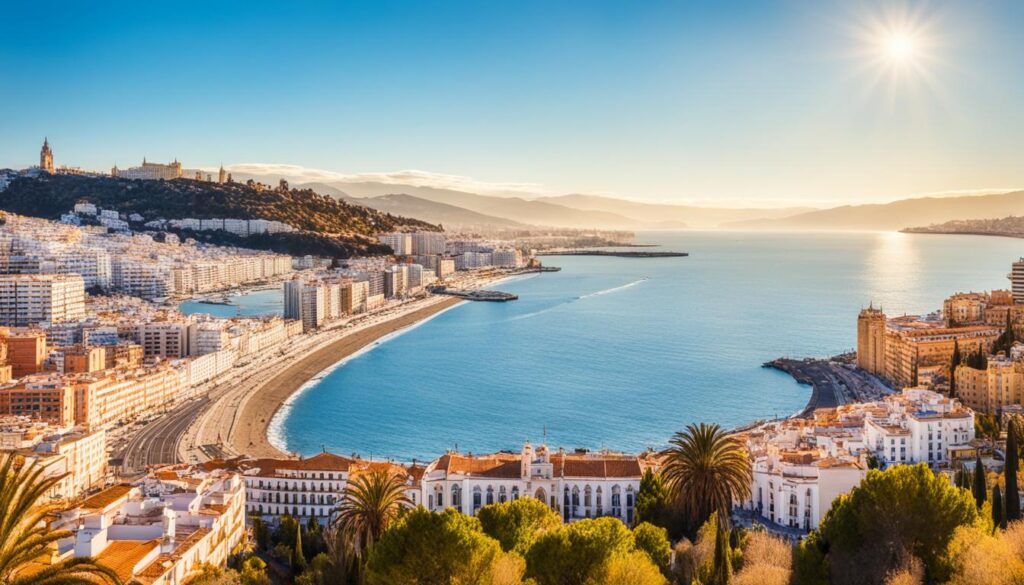The Costa del Sol, in southern Spain, is famous for its sunny Mediterranean climate. It gets over 325 days of sunshine yearly, making it one of the sunniest places on Earth. The weather is mild and rainy in winter and hot and sunny in summer. This makes it a top spot for those looking for a beautiful beach vacation.
Along the coast, you’ll find many towns and cities, each with its own special weather. Places like Estepona, Marbella, Fuengirola, Malaga, and Nerja offer different climates and temperatures. The area is known as the “Costa del Viento” or “Windy Coast” because of the winds. These winds bring rain in the cold months and cool sea breezes in the summer.
Key Takeaways
- The Costa del Sol enjoys over 325 days of sunshine per year, making it one of the sunniest regions in the world.
- Marbella is considered to have the best climate in the area, according to experts.
- Temperatures in Malaga can exceed 30°C during the summer, with July and August being the hottest months.
- Inland towns and villages experience more significant temperature variations between summer and winter compared to the coastal areas.
- The wettest place in Spain, Grazalema, is located near the Costa del Sol region.
Introduction to the Costa del Sol Climate
The Costa del Sol is a beautiful part of the Mediterranean coast in southern Spain. It’s famous for its Malaga weather patterns and Malaga climate. This area, with its coastal towns in Costa del Sol, has a classic Mediterranean climate. It has mild, rainy winters and hot, sunny summers.
Description of the Mediterranean Climate in the Region
The Costa del Sol gets an average of 325 sunny days a year. This makes it one of the sunniest places in Europe. In summer, temperatures can hit up to 31°C (88°F) in July and August. In winter, January is the coldest, with temperatures around 17°C (63°F).
The Costa del Sol weather is affected by the Mediterranean Sea. This sea keeps temperatures in check and brings a cool sea breeze in summer.
Overview of the Coastal Towns and Cities
- The Costa del Sol stretches for 150km along the coast. It has a variety of coastal towns in Costa del Sol, each with its own charm.
- Malaga is the biggest town here, with over 578,000 people living there.
- Places like Marbella, Fuengirola, Torremolinos, and Estepona are also popular. They offer beautiful beaches, resorts, and cultural spots.
- There’s a big expatriate community here, with nearly 300,000 foreigners, making up about 18% of the population.
The Malaga climate and the variety of coastal towns make Costa del Sol a top choice for those wanting a sunny, Mediterranean lifestyle.
Average Temperatures in Malaga
Malaga is a gem on Spain’s Costa del Sol, known for its mild Mediterranean climate. Temperatures range from 12.5°C (54.5°F) in January to 26.5°C (79.5°F) in August. Its location, protected by mountains and facing the Mediterranean Sea, creates a unique climate.
Monthly Temperature Ranges and Extremes
Malaga’s climate shows some dramatic temperature swings. The coldest nights can drop to 1-2°C (34-36°F), but cold days are rare. The lowest temperature ever recorded was -4°C (25°F) in February 1954.
The hottest days can hit 40°C (104°F) or more, with a record of 44°C (111°F) in 1953, 1978, and 1994. These extremes show how varied Malaga’s climate can be.
| Month | Average High (°F) | Average Low (°F) |
|---|---|---|
| January | 62 | 48 |
| February | 64 | 49 |
| March | 68 | 52 |
| April | 72 | 55 |
| May | 77 | 59 |
| June | 82 | 64 |
| July | 86 | 68 |
| August | 88 | 71 |
| September | 84 | 67 |
| October | 77 | 61 |
| November | 68 | 53 |
| December | 62 | 49 |
This data shows the wide range of Temperatures in Malaga throughout the year. It goes from mild winters to hot summers. This gives a clear picture of the Malaga monthly temperatures and Malaga temperature extremes visitors can expect.
Rainfall and Sunshine Patterns
Malaga is a gem on the Costa del Sol, known for its varied weather. It’s famous for its sunny days, but it also has rainfall patterns worth noting.
Rainfall Distribution and Amounts Throughout the Year
Many think Malaga gets a lot of rain, but it doesn’t. It gets about 535 millimeters (21 inches) of rain a year, following a Mediterranean pattern. The wettest months are November and December, with about 100 millimeters (4 inches) each. On the other hand, June, July, and August are very dry, almost no rain at all.
Annual Sunshine Hours and Clear Sky Conditions
Malaga is perfect for sun lovers, with 2,910 sunshine hours a year. July and August are the sunniest, with 11 hours of sunshine daily. This makes Malaga great for enjoying the Mediterranean sun.
| Month | Rainfall (mm) | Sunshine Hours |
|---|---|---|
| January | 60 | 190 |
| February | 60 | 210 |
| March | 50 | 240 |
| April | 40 | 250 |
| May | 30 | 280 |
| June | 10 | 320 |
| July | 5 | 340 |
| August | 5 | 330 |
| September | 20 | 280 |
| October | 60 | 240 |
| November | 100 | 190 |
| December | 100 | 180 |
This table shows the rainfall and sunshine in Malaga each month. It clearly highlights the region’s unique weather patterns throughout the year.
Malaga Weather: Summer Season
Summers in Malaga are hot and sunny. Temperatures range from 28°C (82°F) in June and September to 30-31°C (86-88°F) in July and August. The humidity is high, but the sea breeze cools things down.
On the hottest days, temperatures can hit 35-37°C (95-99°F) or even 40°C (104°F). The sea breeze dries the air, making the heat easier to handle. It’s key to drink plenty of water and take breaks from the sun to stay hydrated.
Typical Summer Temperatures and Humidity Levels
- Average high temperatures in July and August range from 30-31°C (86-88°F)
- Humidity levels can reach up to 70-80% during the hottest and most humid days
- On the warmest days, temperatures can climb as high as 35-37°C (95-99°F) and even reach 40°C (104°F)
Sea Breeze and Cooling Effects
Malaga’s coastal location and the sea breeze are key to cooling the summer heat. This wind lowers the humidity, making the warm weather more pleasant for everyone.
“The sea breeze is a true blessing during the hot summer months in Malaga. It helps to keep the air feeling fresh and comfortable, even on the most sweltering days.”
Malaga Weather: Winter Season
Many people think of Malaga as a place with warm summers. But, the city’s winter is also great. Malaga’s mild winters are a nice break from the cold in other parts of Europe.
In winter, Malaga’s temperatures are between 12.4°C (54.3°F) in January and 13.3°C (55.9°F) in December. You’ll see sunny days and some wind and rain. But, it doesn’t get very cold, and snow is very rare.
| Month | Average Daytime Temperature | Average Nighttime Temperature | Rainfall Days |
|---|---|---|---|
| December | 18°C | 8°C | 4 |
| January | 18°C | 8°C | 4 |
| February | 12°C | 6°C | 7 |
Winter in Malaga is great for seeing the sights. The weather is warm enough for outdoor fun. But, it can get cooler at night, so you might not want to sunbathe.
Even with some rain, Malaga is still a top spot in winter. It’s less crowded, and you can enjoy beautiful walks, sea dips, and stunning sunsets.

For a winter trip to Malaga, pack a light jacket, shorts, t-shirts, jeans, sandals, SPF, sunglasses, and evening clothes. Checking the weather forecast before you go helps plan your trip better.
Spring and Autumn in Malaga
Malaga has a mild and pleasant climate all year. Spring and autumn are especially nice with their sunny days and moderate temperatures. As winter ends, the city gets warmer, making Malaga spring weather perfect for outdoor activities.
From March to May, temperatures in Malaga go from 16°C to 22°C. By May, it can get up to 25°C. The sea warms up too, starting at 17°C in March and hitting 18°C by May. Rain is still possible but less often, making spring great for exploring the city.
When summer ends, Malaga autumn weather brings cooler temperatures. September and October can still be quite warm, with highs of 28°C. But by November, it cools down to a comfortable 19°C. November is the wettest month, though.
The Malaga spring weather and Malaga autumn weather are perfect for enjoying the city’s culture and beautiful coast. These seasons have mild temperatures, some rain, and lots of sunshine. It’s a great time to visit if you want a Mediterranean getaway without the summer heat.
Sea Temperature and Swimming Conditions
The sea temperature in Malaga is affected by its link to the Atlantic Ocean. This makes the water cooler than in other parts of the Mediterranean. Even with a warm climate, the sea in Malaga is not warm enough for swimming.
Monthly Sea Temperature Averages
In June, the sea temperature in Malaga is about 20°C (68°F). As summer goes on, it gets warmer, reaching 22°C (72°F) in July and September. August is the warmest, with a sea temperature of 23°C (73°F).
Even in the summer, the sea temperature in Malaga is cooler than in other places. This is because the Atlantic Ocean’s influence keeps the water from getting too hot. It’s not as warm as in some other areas.
| Month | Average Sea Temperature |
|---|---|
| June | 20°C (68°F) |
| July | 22°C (72°F) |
| August | 23°C (73°F) |
| September | 22°C (72°F) |
“Even during the warmest months, the sea temperature in Malaga remains on the cooler side compared to other Mediterranean destinations.”
The cool swimming conditions in Malaga come from its location and its link to the Atlantic Ocean. If you want warmer waters, you might look at other beaches. But if you like a cool swim, Malaga is perfect.

Best Time to Visit Malaga
Malaga is a vibrant city on Spain’s Costa del Sol coast. It has sunshine, mild temperatures, and lots of outdoor activities all year. Some seasons are better for travelers who want the best weather for their activities.
Ideal Months for Beach Holidays and Outdoor Fun
The summer months from June to mid-September are perfect for beach lovers. Daytime temperatures are between 83°F (28°C) and 87°F (31°C). There are 11 hours of sunshine each day. Evenings are pleasant, with temperatures from 65°F (18°C) to 70°F (21°C).
For those who like milder weather, April and May or mid-September to mid-October are great. These seasons have temperatures from 67°F (20°C) to 78°F (24°C) during the day. Evenings are cooler, from 50°F (10°C) to 58°F (14°C). There are fewer people and lower prices for places to stay.
“The best time to visit Malaga is during the spring months of April and May or the autumn months of September and October.”
These months might have some rain, with 3-4 rainy days on average. But the weather is still great for seeing Malaga’s culture, landmarks, and outdoor fun.
If you want to avoid the busy tourist season and save money, visit from November to February. The weather is cooler, with highs from 62°F (17°C) to 64°F (18°C) and lows around 47°F (8°C) to 48°F (9°C). But there’s still plenty of sunshine, with 174 hours a month.
Malaga is a great place to visit any time of year. Its mild climate and many activities mean you can plan your trip around your favorite weather and activities.
Weather Extremes and Unique Patterns
Malaga is close to North Africa, which means it gets dust storms from the Sahara Desert. These storms can make it very hot and visibility can drop to just 200 meters. The North African influence also brings intense heatwaves, with temperatures over 40°C (104°F).
Dust Storms and the North African Influence
The southern coast of Spain, including Malaga, feels the North African climate’s impact. Dust storms from the Sahara can cross the Mediterranean, bringing high temperatures and bad visibility. These storms change the weather and can be tough for people living or visiting there.
Being on the Costa del Sol, Malaga often sees dust storms that reduce visibility to a few hundred meters. The hot, dry air from North Africa also leads to heatwaves, with temperatures over 40°C (104°F) in summer.
| Weather Phenomenon | Impact on Malaga |
|---|---|
| Dust Storms from North Africa | – Reduced visibility, sometimes down to 200 meters or less – Increased temperatures and dry conditions – Potential disruptions to transportation and outdoor activities |
| North African Heatwaves | – Temperatures exceeding 40°C (104°F) during summer – Increased risk of heat-related health issues – Higher demand for cooling and hydration |
Despite the weather extremes, Malaga’s climate is usually pleasant for visitors. Its location, near the Mediterranean and North Africa, makes the weather varied and sometimes surprising.
“The dust storms from North Africa are a humbling reminder of the power of nature and the interconnectedness of our global climate system.”
Malaga Weather Patterns and Forecasting
Malaga’s weather is shaped by its Mediterranean climate, the Atlantic Ocean, and mountains to the north. These elements make the area mild and sunny, with clear seasonal changes.
For tourists and locals, knowing the weather in Malaga is key. It helps them plan their days and trips. With over 300 days of sunshine per year, it’s a top spot for those who love the sun.
The temperature in Malaga varies from 15°C (59°F) in winter to 30°C (86°F) in summer. July and August can get very hot, up to 40°C (104°F). Winter brings cooler temperatures, between 12-18°C (54-64°F).
Malaga doesn’t get much rain, mostly in autumn and winter. A strong wind, the “Levante,” brings hot air and dryness from the east.
- Malaga enjoys over 300 days of sunshine per year on average.
- Summer season in Malaga lasts from June to September with temperatures around 30°C (86°F).
- Winter season in Malaga lasts from December to February with temperatures around 15°C (59°F).
- Humidity in Malaga averages around 65-75%, particularly noticeable during the summer.
It’s important to check the weather forecast for Malaga. This helps locals and visitors plan their days and trips. Knowing the Malaga weather patterns makes any visit better, whether it’s for the beach or outdoor fun.
“Malaga’s weather is a delightful balance of sunshine, mild temperatures, and occasional sea breezes – making it a year-round destination for those seeking the perfect getaway.”
Conclusion
The Malaga weather and the Costa del Sol region of Spain have a Mediterranean climate. This means mild, rainy winters and hot, sunny summers. The area gets a lot of sunshine, with over 2,900 hours a year, and temperatures don’t get too cold.
Malaga’s weather is shaped by its coastal location. The Mediterranean Sea helps keep temperatures steady. Summers can get very hot, often over 30°C (86°F). Winters are mild, between 10-15°C (50-59°F).
Malaga is great for a vacation any time of the year. You can enjoy the sun or look for a milder climate. The city hosts many events, like the Malaga Fair in August and the Malaga Christmas Lights in December. These events make it a lively place to visit.

